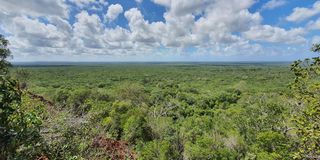Premium
The hidden green treasure that is Arabuko-Sokoke

A panoramic view of Arabuko-Sokoke forest from Nyari View Point. Photo | Pool
What you need to know:
Arabuko is a remnant of the largest block of coastal indigenous dry forest bordering the Indian Ocean that once stretched from Southern Somalia to Northern Mozambique
If you have been to the coast, the beach calls to you first before anything else. It is usually all about the waves, the sun, and the tan. This time, however, my focus was completely diverted to Arabuko-Sokoke forest, Kenya’s largest dry coastal forest.
Courtesy of Kenya Forest Service, we toured the mangrove forests in Kwale, Mombasa, and Kilifi counties and learnt about the rare but powerful trees that may be the solution to our climate change problem. This woodland was our last stop.
We packed up and drove from Malindi to get into the National reserve through the main gate at Gede. It is used by travelers who wish to walk through the nature trail and catch a glimpse of the Golden-rumped elephant shrew, a red-listed endangered mammal that is only found in Arabuko-Sokoke.
Culture centre
Visitors can also get the chance to visit the culture centre and the Kaya Shrine where they would learn about its importance to the Mijikenda community, especially the Waata who were the original protectors of the forest.
Arabuko is a remnant of the largest block of coastal indigenous dry forest bordering the Indian Ocean that once stretched from Southern Somalia to Northern Mozambique. It is one of the six UNESCO biosphere reserves in Kenya.
Our tour guide, Jonathan Mwachongo, took us through the history of the forest highlighting that Arabuko is a hot spot for birdwatchers. It has the second largest population of bird species with over 270 species after Congo forest which is the largest forest on the continent. The Clarke’s Weaver, Sokoke Scops Owl, Spotted Ground Trush, Sokoke pipit, East Coast Alakat, and Amani Sunbird are some of the bird species that are globally threatened and found in Arabuko.
Lucky for us, it was butterfly season. We came across kaleidoscopes of different species flying through the forest which was such a euphoric sight to see.
Different ecosystems
We drove into the dense forest where trees have grown so close to each other, creating a canopy road. It is possible for one to get lost in this part of the forest where all the stations are far apart from each other.
The forest continued to change shape as we got deeper into the thick of it. We got to see the trees switch to and fro three different ecosystems: mixed forest, Brachystegia (tropical timber) forest and Gynometra forest.
We then came across a huge dry femur bone belonging to an elephant. Traces of broken branches showed that a herd of elephants had just passed by. The forest is home to a population of about 200 elephants. A 110 kilometre solar-powered elephant-proof fence was constructed and eliminated human-elephant conflict situations.
Arabuko Sokoke is Waata for 'forest of the thin elephant’: arbimeaning elephant, huk'o meaning thin, and sokoke "short (trees)".
Earlier this year, there was a leopard sighting showing that there are animals crossing from Tsavo East National Park into the forest. It was suspected to have wandered out of the park in search of prey which Arabuko has plenty of such as Suni, Dikidik and Ader’s duiker. However, the forest has enough predators such as hyenas and foxes to keep the ecosystem balanced.
Nature healing power
After a long, bumpy ride we arrived at the Nyari viewpoint. A glorious view of the forest stood tall before us with the splashing of the Indian Ocean on Mida Creek being spotted at the farthest end. Surrounded by all the green and fresh air, you could already feel the healing power of nature away from the city’s loud noise and skyscrapers. Firsthand experience of the forest’s calming effect gives life to John Muir’s saying, “Come to the woods, for here is rest.”
Other than birdwatching and sightseeing, you can camp in the forest or cycle through it with a group of friends under the protection of the forest guards.
The forest has so much potential to attract more tourists if the treehouse next to the watering hole where all the animals come to quench their thirst is properly refurbished and rehabilitated.
Charges
Each Kenyan and East African Community citizen was required to pay Sh232 via MPesa only. Nonresidents are required to pay Sh696 at the ticket office at the main Gede Forest Station which is open from 6am to 6pm. You can also enter via Jilore and Sokoke forest stations. The forest is under the protection of the Kenya Forest Service and Kenya Wildlife Service.





